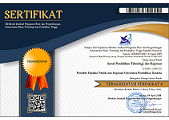TOURIST BEHAVIOR MODEL: PENGARUH MOTIVASI DAN CITRA DESTINASI TERHADAP NIAT DAN KEPUTUSAN BERKUNJUNG WISATAWAN DI PANTAI PENIMBANGAN
DOI:
https://doi.org/10.23887/jptkundiksha.v21i1.73768Keywords:
Perilaku wisatawan, parametrik, Goodness of FitAbstract
Adapun tujuan penelitian ini yaitu sebagai upaya yang dilakukan salah satu upaya untuk meningkatkan dan mempengaruhi keputusan wisatawan untuk memilih berkunjung ke DTW Pantai Penimbangan dibanding dengan destinasi wisata lain yang sejenis maka Peran citra destinasi dan motivasi wisatawan menjadi salah satu faktor penentu. Oleh karena itu penelitian ini akan memberikan kajian khusus untuk mempelajari perilaku (behavioral) yang mempengaruhi wisatawan untuk mengunjungi DTW Pantai Penimbangan). Penelitian ini menggunakan pendekatan metide statistia parametrik dengan 100 responden dan dianalisis melalaui smart PLS- SEM 3.0. adapun hasil penelitian ini yaitu Berdasarkan Hasil Penelitian Adapun Kesimpulan Yaitu , Pertama Terdapat Hubungan Signifikan Antara Variabel Destination Image Terhadap Keputusan Berkunjung Wisatawan. Kedua Terdapat Hubungan Signifikan Antara Destination Image Terhadap Motivasi Wisatawan Untuk Berkunjung. Ketiga Terdapat Hubungan Signifikan Antara Destination Image Terhadap Niat Wisatawan Berkunjung . Keempat Tidak Terdapat Pengaruh Antara Variabel Motivasi Terhadap Keputusan Berkunjung . Kelima Terdapat Pengaruh Signifikan Antara Variabel Motivasi terhadap Niat Wisatawan Berkunjung . Keenam Terdapat Hubungan Signifikan Antara Niat Wisatawan Berkunjung Terhadap Keputusan Wisatawan Berkunjung. Selanjutnya Dari Model Yang Dihasilkan Dapat Disimpulkan Berada Pada Ketegori Goodness Of Fit Atau Model Yang Dihasilkan Dapat Diterima. Implikasi dari hasil penelitian ini, secara teoritis dapat mengidentifikasi dan mengukur hubungan variabel yang jarang dikaji, yaitu hubungan destination image terhadap niat berkunjung melalui motivasi wisatawan. pada dimensi operasional DTW Pantai Penimbangan, memeberikan gambaran lebih luas potensi DTW dan memberikan diferensiasi terhadap DTW lain yang sejenis.
References
D. W. Iklima Aminatuz Zuhriah, Stella Alvianna, Syarif Hidayatullah, Ryan Gerry Patalo, “Dampak Attraction , Accessibility , Amenity , Ancillary Terhadap Minat Berkunjung Wisatawan Di Destinasi Wisata Religi Makam Gus Dur Kabupaten Jombang,” J. TeslaPerhotelan -Destinasi Wisata -Perjalanan Wisata, vol. 2, no. 1, pp. 1–11, 2022.
S. Lingga and Z. Kemala, “Analisis Motivasi Wisatawan Terhadap Keputusan Berkunjung di Desa Wisata Lamajang,” Manaj. dan Pariwisata, vol. 1, no. 1, pp. 66–75, 2022, doi: 10.32659/jmp.v1i1.200.
I. Safitri, A. M. Ramdan, and E. Sunarya, “Peran Produk Wisata dan Citra Destinasi terhadap Keputusan Berkunjung Wisatawan,” J. Ilmu Manaj., vol. 8, no. 3, p. 734, 2020, doi: 10.26740/jim.v8n3.p734-741.
D. Fitroh, Syakir Kamil Ainul Hamid and L. Hakim, “Pengaruh Atraksi Wisata dan Motivasi Wisatawan terhadap Keputusan Berkunjung,” Adm. Bisnis, vol. 42, no. 2, pp. 18–25, 2017.
R. M. M. Vázquez, J. M. García, and J. de P. Valenciano, “Analysis and trends of global research on nautical, maritime and marine tourism,” J. Mar. Sci. Eng., vol. 9, no. 1, pp. 1–19, 2021, doi: 10.3390/jmse9010093.
W. Wattanacharoensil and D. La-ornual, “A systematic review of cognitive biases in tourist decisions,” Tour. Manag., vol. 75, no. March, pp. 353–369, 2019, doi: 10.1016/j.tourman.2019.06.006.
Y. Yoon and M. Uysal, “An examination of the effects of motivation and satisfaction on destination loyalty : a structural model,” vol. 26, pp. 45–56, 2005, doi: 10.1016/j.tourman.2003.08.016.
C. Chen and S. Phou, “A closer look at destination : Image , personality , relationship and loyalty,” Tour. Manag., vol. 36, pp. 269–278, 2013, doi: 10.1016/j.tourman.2012.11.015.
Á. Daniel, “Management of Tourist Destinations : The Expectations of Guests on eWOM Generation in Maldonado ( Uruguay ),” 2020.
E. Juvan and D. G. Omerzel, “Tourist Behaviour : An Overview of Models to Date,” Manag. Int. Conf., pp. 23–33, 2017.
M. Afshardoost and M. S. Eshaghi, “Destination image and tourist behavioural intentions: A meta-analysis,” Tour. Manag., vol. 81, no. April, p. 104154, 2020, doi: 10.1016/j.tourman.2020.104154.
S. A. Cohen, G. Prayag, and M. Moital, “Consumer behaviour in tourism: Concepts, influences and opportunities,” Curr. Issues Tour., vol. 17, no. 10, pp. 872–909, 2014, doi: 10.1080/13683500.2013.850064.
I. P. H. B. Utama and I. G. A. K. Giantari, “PERAN CITRA DESTINASI MEMEDIASI PENGARUH E-WOM TERHADAP NIAT BERKUNJUNG KEMBALI WISATAWAN (Studi Pada Obyek Wisata Taman Edelweis Bali),” E-Jurnal Manaj. Univ. Udayana, vol. 9, no. 4, p. 1230, 2020, doi: 10.24843/ejmunud.2020.v09.i04.p01.
N. Purnama and N. Marlena, “Pengaruh E-Wom Dan Harga Terhadap Niat Berkunjung Kembali Pada Gunung Semeru,” J. Pendidik. Tata Niaga, vol. 10, no. 1, pp. 1626–1634, 2022, doi: 10.26740/jptn.v10n1.p1626-1634.
R. N. Chasanah and A. Wijaya, “Pengaruh Motivasi Wisata Dan Destination Image Terhadap Niat Wisatawan Untuk Berkunjung Ke ‘ 10 New Bali,’” Value J. Manaj. dan Akunt., vol. 15, no. 2, pp. 268–280, 2020, doi: 10.32534/jv.v15i2.1476.
J. Gosal, E. Andajani, and S. Rahayu, “The Effect of e-WOM on Travel Intention, Travel Decision, City Image, and Attitude to Visit a Tourism City,” vol. 115, no. Insyma, pp. 261–265, 2020, doi: 10.2991/aebmr.k.200127.053.
T. T. A. Firdaus, “Pengaruh Destination Image Terhadap Motivasi Berkunjung Wisatawan Ke Kabupaten Sumedang,” Manaj. Resort dan Leis., vol. 12, no. 2, pp. 68–76, 2015.
R. Priyanto, Widiartono, and S. Listyorini, “Pengaruh Produk Wisata, Destination Image, dan Word of Mouth terhadap Keputusan Berkunjung (Studi Kasus pada Pengunjung Objek Wisata Goa Kreo Semarang),” J. Adm. Bisnis, vol. 5, no. 1, pp. 217–226, 2016.
D. Rizki, M. Muksin, and F. I. Administrasi, “Pengaruh Motivasi Terhadap Keputusan Berkunjung Wisatawan di Ekowisata Mangrove Wonorejo Surabaya,” J. Adm. Bisnis (JAB)|, vol. 55, no. 1, pp. 196–203, 2018.
Novita Eka Indriyani and Yessy Artanti, “Peran Citra Destinasi, E-Wom, Dan Travel Constraints Pada Niat Berkunjung Wisata Pantai Di Kota Surabaya, Jawa Timur,” JRMSI - J. Ris. Manaj. Sains Indones., vol. 11, no. 2, pp. 260–281, 2020, doi: 10.21009/jrmsi.011.2.04.
K. K. Wong, “Partial least squares structural equation modeling ( PLS-SEM ) techniques using SmartPLS,” no. JANUARY 2013, 2015.
N. N. A. Purnami and I. G. A. Oka Suryawardani, “The Effect of the Quality of Services on the Visitors’ Satisfaction and Desire to Pay a Revisit to the Bali Pulina Agrotourism,” E-Journal Tour., vol. 5, no. 2, p. 62, 2018, doi: 10.24922/eot.v5i2.42590.
J. Henseler et al., “Organizational Research Methods,” no. 2013, 2014, doi: 10.1177/1094428114526928.
C. M. R. Joe F Hair, Jeffrey Joe Risher, Marko Sarstedt, “When to use and how to report the results of PLS-SEM,” Eur. Bus. Rev., 2018.
Downloads
Published
Issue
Section
License
Authors who publish with the JPTK agree to the following terms:- Authors retain copyright and grant the journal the right of first publication with the work simultaneously licensed under a Creative Commons Attribution License (CC BY-SA 4.0) that allows others to share the work with an acknowledgment of the work's authorship and initial publication in this journal
- Authors are able to enter into separate, additional contractual arrangements for the non-exclusive distribution of the journal's published version of the work (e.g., post it to an institutional repository or publish it in a book), with an acknowledgment of its initial publication in this journal.
- Authors are permitted and encouraged to post their work online (e.g., in institutional repositories or on their website) prior to and during the submission process, as it can lead to productive exchanges, as well as earlier and greater citation of published work. (See The Effect of Open Access)












